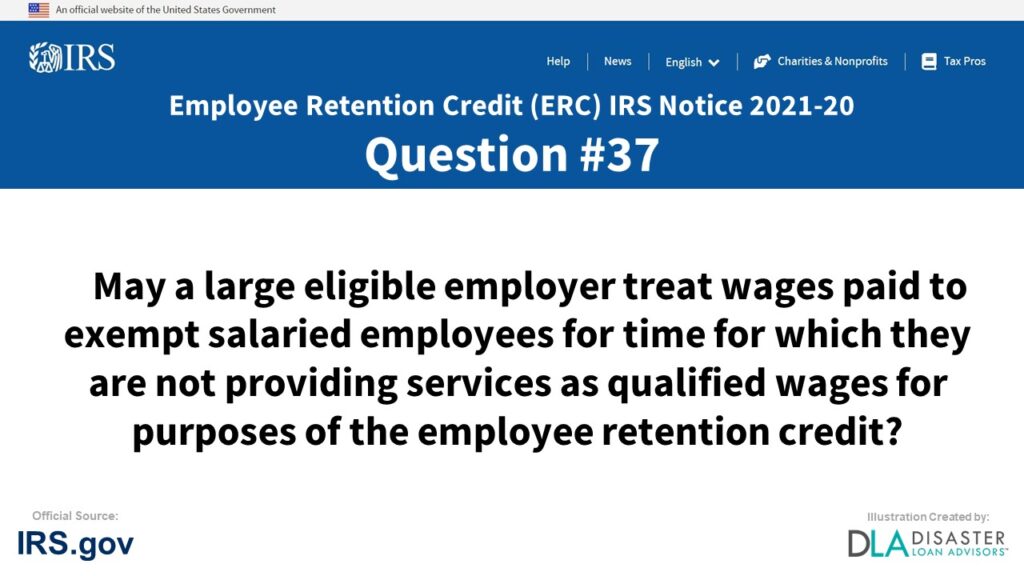
Question #37:
May a large eligible employer treat wages paid to exempt salaried employees for time for which they are not providing services as qualified wages for purposes of the employee retention credit?
Found under the G. Qualified Wages section of the Employee Retention Credit (ERC) IRS Notice 2021-20 with updated guidance to help business owners follow the current ERC rules.
The answer to question #37, May a large eligible employer treat wages paid to exempt salaried employees for time for which they are not providing services as qualified wages for purposes of the employee retention credit?, can be found below.
ERC IRS Notice 2021-20 Question #37:
G. Qualified Wages
May a large eligible employer treat wages paid to exempt salaried employees for time for which they are not providing services as qualified wages for purposes of the employee retention credit?
Yes, provided the wages paid to the exempt salaried employees are for the time that they are not providing services due to either a full or partial suspension of operations (due to a governmental order) or a significant decline in gross receipts.
An eligible employer may use any reasonable method to determine the number of hours that a salaried employee is not providing services, but for which the employee receives wages either at the employee’s normal wage rate or at a reduced wage rate.
Reasonable methods include the method (or methods) the employer uses to measure exempt employees’ entitlement to leave on an intermittent or reduced leave schedule under the Family and Medical Leave Act, or the method the employer uses to measure exempt employees’ entitlement to and usage of paid leave under the employer’s usual practices. It is not reasonable for the employer to treat an employee’s hours as having been reduced based on an assessment of the employee’s productivity levels during the hours the employee is working.
Example 1: Employer I, a large eligible employer operating a fitness club business, closed all of its locations in City B due to a governmental order issued by City B’s mayor. Employer I continues to pay its exempt managerial employees their regular salaries. While the clubs are closed and there is not sufficient administrative work to occupy the managerial employees full-time, they continue to perform some accounting and similar administrative functions. Employer I has determined, based on the time records maintained by employees, that they are providing services for 10 percent of their typical work hours. Employer I does not take the wages into account under sections 7001 and 7003 of the FFCRA. In this case, 90 percent of wages paid to these employees during the period the clubs were closed are qualified wages.
Example 2: Employer J, a large eligible employer operating a consulting firm, closed its offices due to various governmental orders and required all employees to telework. Although Employer J believes that some of its employees may not be as productive while working remotely, employees are working their normal business hours. Because employees’ work hours have not changed, no portion of the wages paid to the employees by Employer J are qualified wages.
For more information about the Employee Retention Credit (ERC) IRS Notice 2021-20, visit the Internal Revenue Service (IRS) Department of the Treasury, official IRS.gov tax website.
Conclusion and Summary on May a large eligible employer treat wages paid to exempt salaried employees for time for which they are not providing services as qualified wages for purposes of the employee retention credit? – #37 ERC IRS Notice 2021-20
The answer to Question #37: “May a large eligible employer treat wages paid to exempt salaried employees for time for which they are not providing services as qualified wages for purposes of the employee retention credit?” was answered in detail above. It was found under section “G. Qualified Wages” in IRS Notice 2021-20.
Leave a comment below if you have further questions on the Employee Retention Credit (ERC) or for clarifications in May a large eligible employer treats wages paid to exempt salaried employees for time for which they are not providing services as qualified wages for purposes of the employee retention credit?
Employee Retention Tax Credit (ERTC): Expert Assistance to Claim Your Business ERC Credit
Up to a $26,000 ERC Refund from the IRS for Each Employee
Disaster Loan Advisors can assist your business with the complex and confusing Employee Retention Credit (ERC), Form 941-X, and the Employee Retention Tax Credit (ERTC) program.
Depending on eligibility, business owners and companies can receive up to $26,000 per employee based on the number of W2 employees you had on the payroll in 2020 and 2021.
The ERC / ERTC Tax Credit Program is a valuable IRS tax credit you can claim. This is money you have already paid to the IRS in payroll taxes for your W2 employees.
We DO NOT charge a percentage (%) of your ERC Refund like some companies are charging. Some ERC firms out there are charging upwards of 15% to 35% of your ERC refund!
Our professional ERC fee and pricing structure is very reasonable in comparison.
If you are looking for an ERC Company that believes in providing professional ERC Services and value, in exchange for a fair, reasonable, and ethical fee for the amount of work required, Disaster Loan Advisors is a good fit for you.
Schedule Your Free Employee Retention Credit Consultation to see what amount of employee retention tax credit your company qualifies for.
Cover Image Credit: Irs.gov / IRS Notice 2021-20 / Disaster Loan Advisors.
